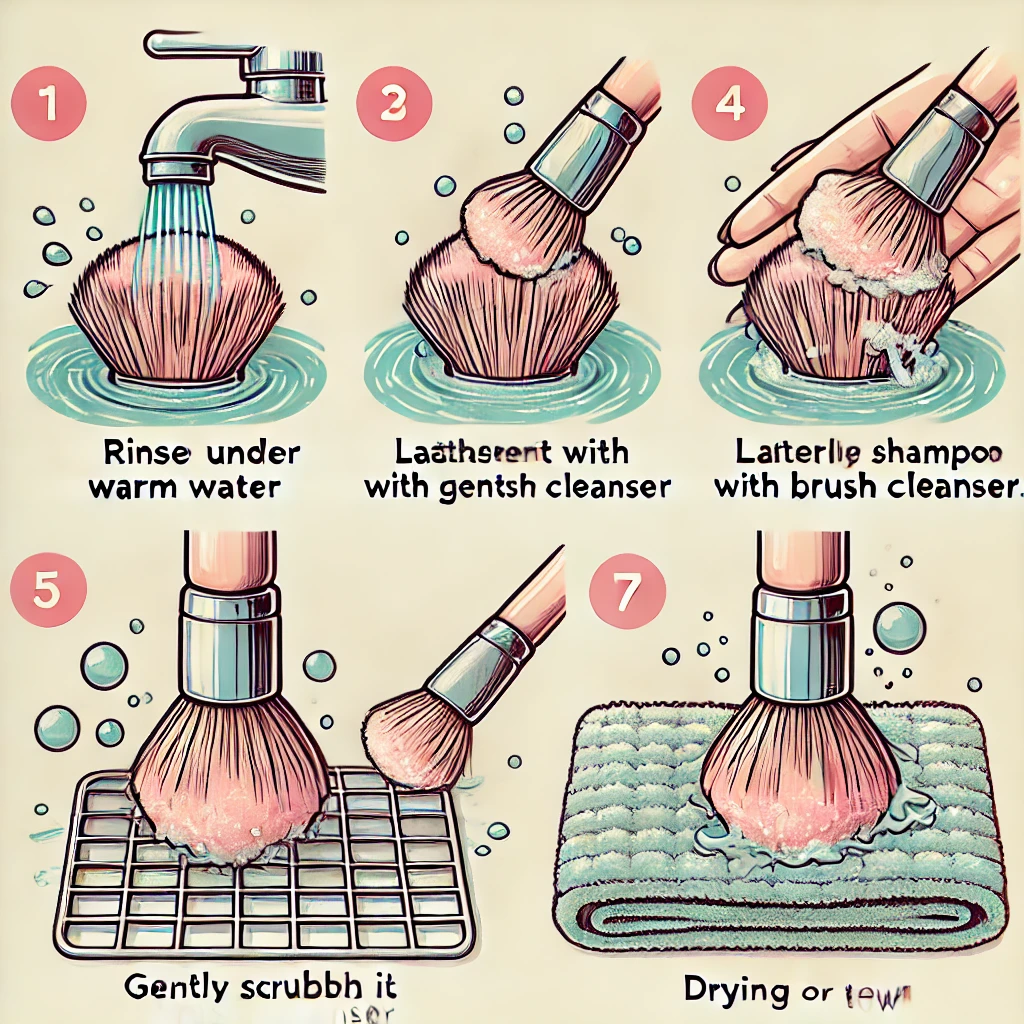Regarding your beauty routine, washing your makeup brushes might not seem like the most glamorous task. Still, it is one of the most essential. Over time, your brushes collect makeup residue, oil, dirt, and bacteria, which can affect your skin and the brushes’ performance. If you’re wondering how to wash a makeup brush properly, you’re in the right place. This article will give you a step-by-step guide to cleaning your makeup brushes efficiently, ensuring hygiene and longevity.

Why Is It Important to Clean Makeup Brushes ?
Before diving into the cleaning process, let’s quickly look at why it’s crucial to clean your makeup brushes regularly:
- Prevent Bacteria Buildup: Brushes collect dead skin cells, oils, and bacteria over time. When not cleaned, they can transfer bacteria back onto your skin, leading to acne, infections, and other skin irritations.
- Improve Makeup Application: Dirty brushes need to pick up makeup evenly. Clean brushes ensure that your makeup applies smoothly, without streaks or clumps.
Extend Brush Life: Regular cleaning preserves the quality and shape of the bristles, allowing you to get the most out of your investment in good-quality brushes.

How Often Should You Clean Your Makeup Brushes?
The frequency of cleaning depends on the type of brush:
- Foundation and concealer brushes: Clean weekly. These brushes come into direct contact with liquid and cream products, which harbor more bacteria than powder-based ones.
- Powder and eyeshadow brushes: If used daily, clean every 2-3 weeks. Brushes with dry products are less prone to bacteria buildup but still need regular cleaning.
Sponges: Clean them twice a week, especially if you use them to apply liquid products like foundation or cream blush.
How to Wash a Makeup Brush: Step-by-Step Guide
Washing your makeup brushes may seem tedious, but it’s a simple process once you know how. Follow these steps to get your brushes back in tip-top shape.
- Gather Your Cleaning Supplies
Before you begin, you’ll need a few items:
- Mild shampoo or brush cleaner: A gentle formula prevents bristle damage. Baby shampoo or a makeup brush-specific cleaner works best.
- Bowl of lukewarm water: Warm water helps to break down makeup and oils, but avoid hot water as it can loosen the glue holding the brush bristles together.
- Towel or paper towels: To dry your brushes after cleaning.
- Brush cleaning mat or glove (optional): These tools can help scrub off the residue more effectively.
- Rinse the Brushes
Start by rinsing your brushes under lukewarm water, focusing on the bristles. Be careful not to wet the handle or the ferrule (the metal part that connects the bristles to the handle), as moisture can weaken the glue and cause shedding.
- Shampoo the Brushes
Next, add a small shampoo or brush cleanser to a water bowl. Dip the bristles into the soapy water, swirling gently. You can also massage the bristles in the palm of your hand or use a brush cleaning mat to work the cleanser through.
Repeat this step several times for extra-dirty brushes until the water clears.
- Rinse Again
After shampooing, rinse the brushes thoroughly under lukewarm running water. Ensure no soap or makeup residue is left behind. If the water doesn’t run clear, you may need to shampoo and rinse again.
- Squeeze and Reshape
Once the brushes are clean, gently squeeze the excess water out of the bristles using a clean towel. Be sure not to tug or pull on the bristles. After pressing, reshape the brush head to its original form.
- Dry the Brushes
Lay your brushes flat on a clean towel, with the brush head hanging off the edge. This will help them dry faster and ensure that water doesn’t seep into the ferrule, which can loosen the glue and cause shedding.
Never dry brushes upright—the water can seep into the base, weakening the glue and damaging the brush. Ideally, let them dry overnight for the best results.
Cleaning Makeup Sponges
If you use beauty sponges, they also need regular cleaning. Sponges can soak up product, moisture, and bacteria, leading to clogged pores and potential skin issues.
- Wet the Sponge
Soak your makeup sponge in warm water. Squeeze it a few times under the water to allow it to absorb the liquid.
- Apply Cleanser
Add a drop of liquid dish soap or a gentle cleanser to the sponge. Massage it by squeezing the sponge repeatedly, ensuring the soap reaches all areas.
- Rinse and Squeeze
Rinse the sponge thoroughly under running water and squeeze until all the soap is gone. If your sponge is still stained, you can repeat the cleansing process.
- Let It Dry
After rinsing, squeeze out excess water and set the sponge on a clean towel to air dry. Don’t store it in an enclosed container while it’s still damp; this can promote bacteria growth.

Best Cleaning Products for Makeup Brushes
There are many products available for cleaning makeup brushes. Some of the top options include:
- Dawn Dish Soap: Highly effective for cutting through oils and stubborn makeup products, particularly for synthetic brushes.
- Beautyblender Solid Blendercleanser: This solid soap works wonders on brushes and sponges and is highly portable.
- Cinema Secrets Brush Cleaner: This professional-grade cleaner is excellent for quick cleaning, as it disinfects and dries fast.
- Sephora Collection Brush Shampoo: An affordable and efficient option for deep cleaning.
Savon de Marseille Bar Soap: A gentle, organic option perfect for natural hair brushes.
Tips for Maintaining Your Makeup Brushes
- Avoid getting the ferrule wet: Excess water can loosen the glue and cause the bristles to fall out.
- Condition your brushes: If natural hair brushes feel stiff, apply a small amount of hair conditioner to the bristles after cleaning. Rinse thoroughly and let them dry as usual.
- Deep clean once a month: Even with regular weekly cleaning, your brushes will benefit from a deeper clean at least once a month. Use a more thorough cleaning method, like soaking the brushes in a brush-cleaning solution.
- Don’t share your brushes: Sharing makeup brushes can spread bacteria and lead to breakouts or infections.
Replace when necessary: If your brushes start shedding bristles or lose their shape, it might be time to invest in new ones.
Common Mistakes to Avoid When Washing Makeup Brushes
Even when you’re diligent about cleaning your brushes, there are a few common mistakes that can shorten the lifespan of your brushes or impact their performance:
- Using hot water: Always use lukewarm water, as hot water can damage the bristles and glue.
- Not rinsing thoroughly: Soap residue left in the bristles can harden and cause irritation when applied to the skin.
- Drying brushes upright: Water will seep into the handle and cause damage. Always dry brushes flat with the bristles hanging off the edge.
Skipping regular cleaning: Dirty brushes lead to bacteria buildup, which can cause breakouts. Make it a habit to clean them at least once a week.
Conclusion :
Learning how to wash a makeup brush is an integral part of your beauty routine, and keeping your brushes clean is essential for maintaining both skin health and makeup application quality. With the steps outlined in this guide, you can wash your brushes efficiently, prolong their lifespan, and keep bacteria at bay.
Remember, regular cleaning doesn’t have to be a hassle. Just make it part of your routine, and your skin and brushes will thank you!
Following this guide will ensure that your makeup brushes stay pristine and that your skin remains healthy and radiant. Proper care of your brushes is as critical as the makeup products you use, so don’t neglect this crucial step.
Why is it important to clean makeup brushes regularly?
Regular cleaning prevents bacteria buildup, improves makeup application, and extends the life of the brushes. Dirty brushes can lead to skin problems such as acne, infections, and irritation.
How often should I clean my makeup brushes?
Foundation and concealer brushes: Clean weekly due to liquid and cream product buildup.
Powder and eyeshadow brushes: Clean every 2-3 weeks.
Makeup sponges: Clean twice a week, especially when using with liquid products.
How do I clean my makeup brushes?
Rinse the bristles under lukewarm water, avoiding the handle.
Shampoo the bristles with a gentle cleanser, massaging them in the palm of your hand or using a cleaning mat.
Rinse thoroughly to remove all soap and makeup residue.
Squeeze out excess water and reshape the bristles.
Dry the brushes flat on a towel with the bristles hanging off the edge to prevent water from seeping into the handle
What are some recommended brush cleaning products?
Dawn Dish Soap for removing oils and makeup.
Beautyblender Solid Blendercleanser for both brushes and sponges.
Cinema Secrets Brush Cleaner for fast disinfecting and quick drying.
Savon de Marseille Bar Soap for natural hair brushes
Can I use hot water to clean my brushes?
No, hot water can damage the bristles and loosen the glue holding them together. Always use lukewarm water
What common mistakes should I avoid when cleaning brushes?
Using hot water instead of lukewarm.
Not rinsing thoroughly, which leaves soap residue that can irritate the skin.
Drying brushes upright, which causes water to seep into the handle and damage the glue.
Skipping regular cleaning, which leads to bacteria buildup






Leave a Reply